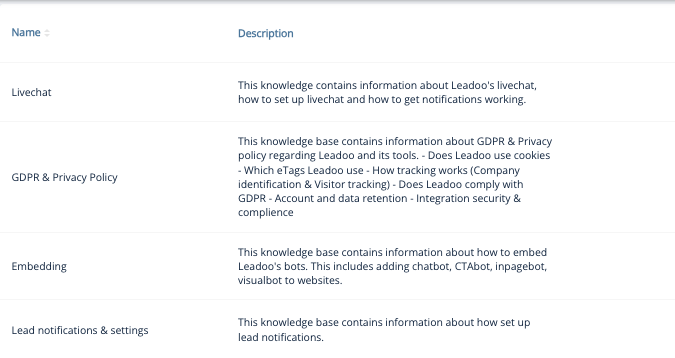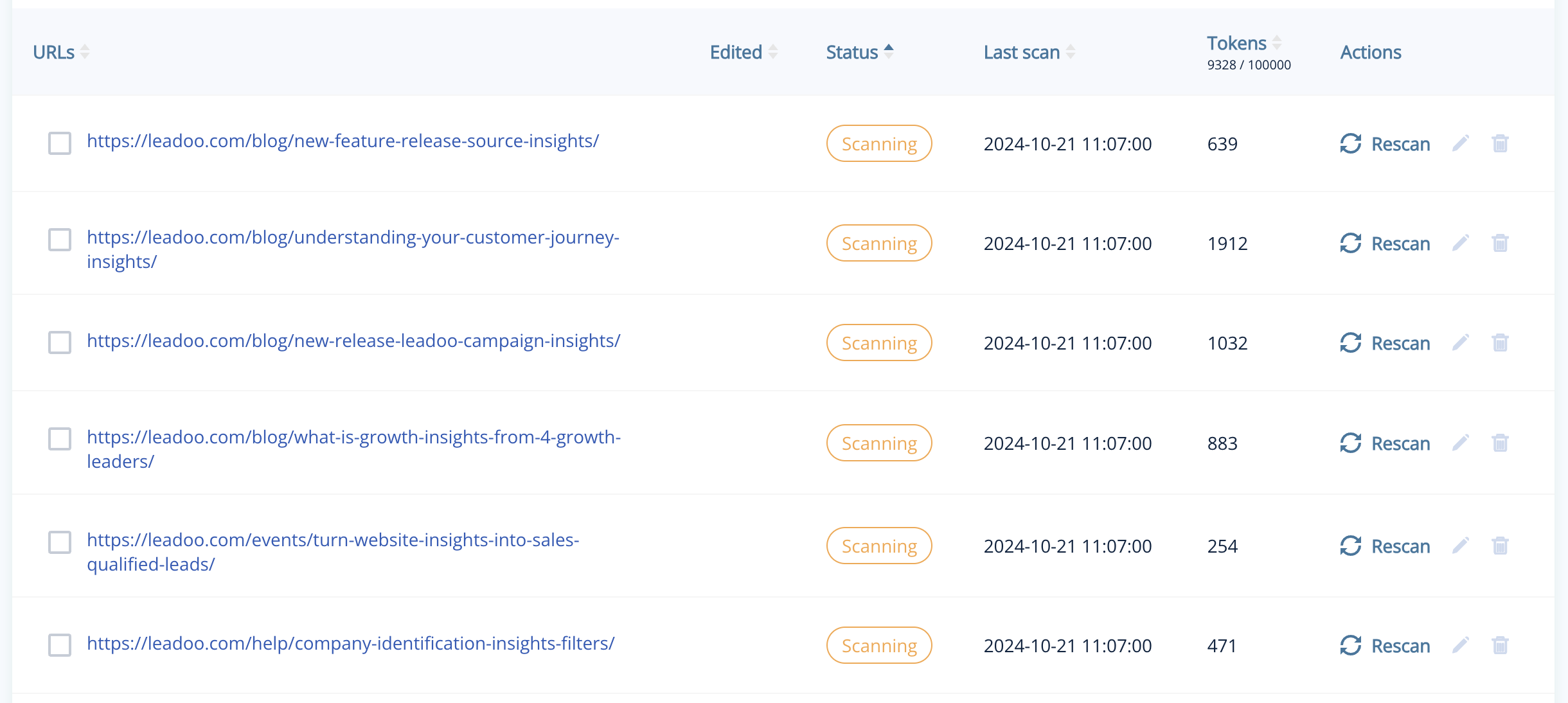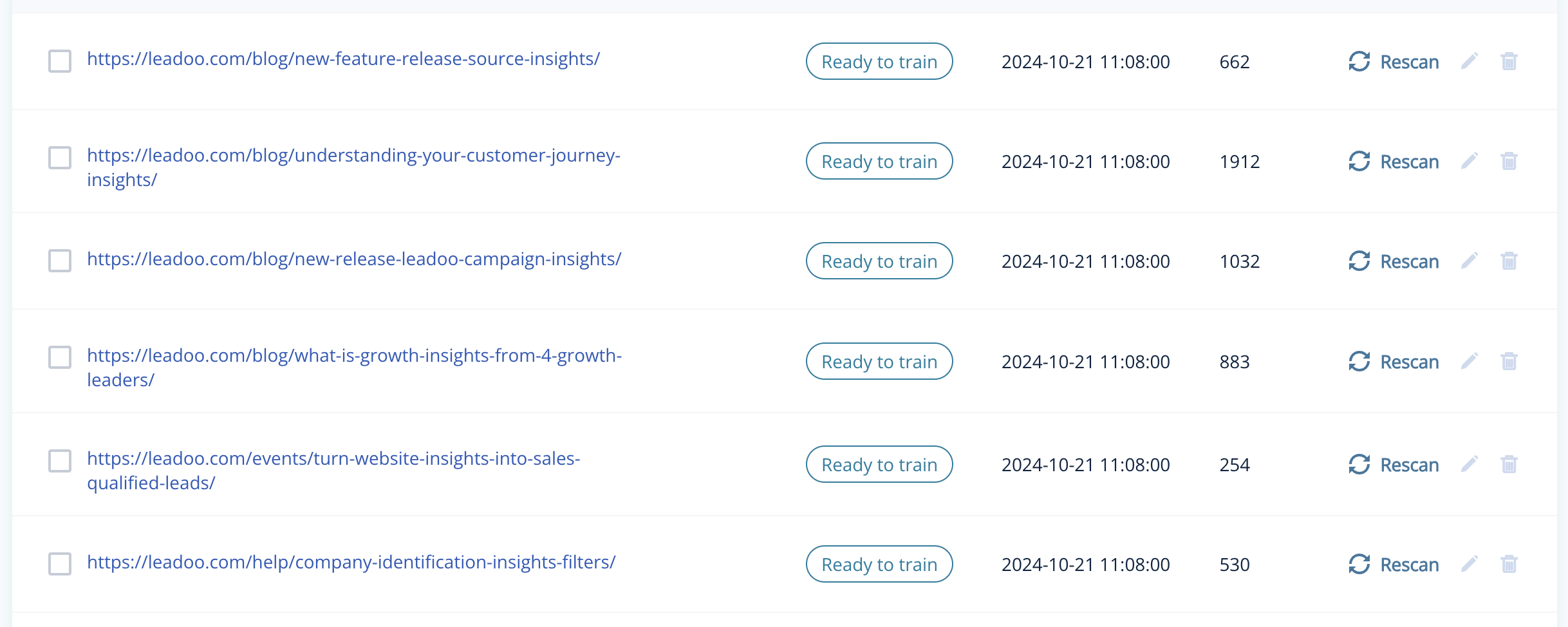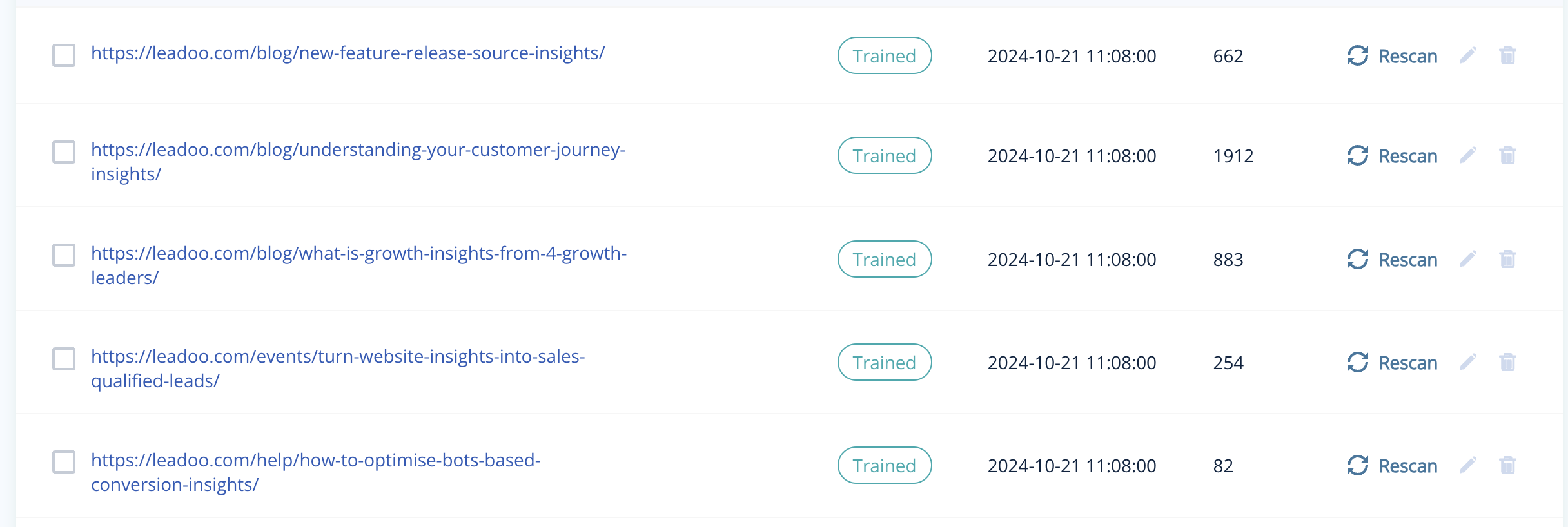If you’re new to Leadoo AI jump over to this article to give you an overview of what it is and how you can use it in your Leadoo bots – Leadoo AI Overview: Understanding its Features and Integrating with Your Bots.
If you’re looking for a step-by-step guide on how to use AI in your Leadoo bots, this is the place to start!
Contents
- What is a Knowledge Base?
- How to Build Your First Knowledge Base
- Adding data sources
- Training your Knowledge Base
- Editing the content in the Knowledge Base
- Troubleshooting
- What to read next
What is a Knowledge Base?
A knowledge base is Leadoo AI’s library of all the information it needs to know to answer your customer queries. This is where you train the AI on all the content and information you think will be most relevant.
You can train the AI using a combination of URLs and documents, and the AI can scan and train on your content in just a few minutes, making setup quick and easy!
Our #1 Tip: Use Multiple Knowledge Bases
Think of your knowledge bases as organised “buckets” of information. If everything is thrown together, it can be tricky for the AI to find the most relevant answers, which can reduce response accuracy. That’s why Leadoo AI gives you the option to create multiple knowledge bases and use them all within one AI node for more precise results.
For instance, if you run an e-commerce business, you might set up separate knowledge bases for “Product Details,” “Shipping & Delivery,” “Returns & Exchanges,” and “Account Help.” This way, customers get responses tailored to their specific needs—whether they’re looking for product specs, order tracking, or account support.
By giving each knowledge base a clear title and description, you make it easy for the AI to understand what information resides in each “bucket.” With this guidance, the AI can quickly search the right knowledge base and deliver accurate, relevant answers to your customers.
How to Build Your First Knowledge Base
1. Navigate to AI in the left-hand menu, then click Create an AI knowledge base in the top-right corner.
2. Provide a name and description for your knowledge base. If you have multiple knowledge bases, including a clear description is important. Leadoo AI first reviews the descriptions of each knowledge base to determine which one to use to find the answer to the user’s question. After that, it examines the content of the selected knowledge base.
For example, on our knowledge base about embedding, this is the description that accompanies it:
This knowledge base contains information about how to embed Leadoo’s bots. This includes adding chatbot, CTAbot, InpageBot and VisualBot to websites.

3. Choose automatic rescanning frequency. If your website is regularly updated, it’s best practice to enable automatic rescanning to keep the AI’s knowledge fresh.
Adding data sources
You can add multiple data sources:
Document Scanning: Useful for content stored outside public web pages, such as PDFs or spreadsheets with product details or FAQs.
Domain Scanning: Automatically search your website by including/excluding specific keywords. This method focuses on relevant content rather than scanning the entire site.
For example, to build a knowledge base on “Leadoo Insights,” set up the search using rules the rules below.
1. Select domain as the source type
2. Add your website URL: https://leadoo.com
3. Include rules: *insights*
The asterisk (*) acts as a wildcard in this case, allowing the crawler to search all URLs on leadoo.com that contain the word “insights” anywhere in the URL, regardless of what comes before or after it. If we only used *insights, the crawler would not include any URLs that had any other text after the word “insights.”
You can add multiple include or exclude rules by clicking on the plus button. This works as an OR condition e.g. scan all pages that include insights or conversion.
4. Select the maximum number of pages you want to scan.
5. Click Scan webpages. After a few minutes, you should see pages populating in the AI knowledge base section below.
Page Scanning: Manually add specific URLs by selecting the “Page” data source.
Text scanning: Manually input text for AI training.
Training your Knowledge Base
As your data is scanned, sources will show statuses such as Scanning, Ready to Train, or Trained.
Once trained you can review the content by clicking the status label, which will display the information that has been captured.
Editing the content in the Knowledge Base
If, for any reason, you’re unhappy with the content that the Knowledge Base has scanned and trained you can edit this directly. Simply click on the pencil icon before the page, document etc. This will allow you to make any changes without the need for recanning and training content.
Your knowledge base is now ready to use within your Leadoo bot! Remember you can add and remove sources from a knowledge base at any time.
Troubleshooting
No pages are appearing when I try to scan by domain
1. Ensure you’ve adjusted the number of pages to scan
2. Ensure You Have a Public Sitemap
Domain scanning requires your website to have a public sitemap, which is also essential for SEO. To check if you have one, visit: https://[YOUR WEBSITE URL]/robots.txt. If this doesn’t work then contact your website developers for more information.
You should see something like this:
My sources are scanning but some of the status messages show as Train Error
Try rescanning the source. Click the rescan icon on the right-hand side or, tick the box on the left-hand side of the source and click Sync Selected.
The AI isn’t picking up all the content from the source
Occasionally, Leadoo AI may not capture all the content from your sources. This can occur due to certain webpage elements optimised for page speed or user experience that are incompatible with AI crawlers. These issues can also inadvertently affect your SEO. Understanding these problematic elements can help ensure that essential content remains accessible to the AI.
Elements That Can Cause Problems:
- Accordions
Content within accordion sections is only visible when a user clicks to expand them. AI crawlers typically cannot interact with these elements, resulting in missed content. To ensure this information is included, consider expanding important accordions or providing alternative ways for the AI to access the hidden content. - Dynamic Content
Content that only loads when selected or scrolled into view can be problematic. Since AI crawlers cannot trigger these actions, such content may remain uncaptured. To mitigate this, ensure that critical information is loaded statically or provide separate pages where essential content is fully visible without user interaction. - Linked Content
Information that is hyperlinked to other pages may not be automatically followed by the AI. To ensure comprehensive coverage, you need to add the URLs of these linked pages individually to your knowledge base. This ensures that the AI can access and utilise all relevant information across your website. - Gated Content
Content behind a login, form, or other gatekeepers is inaccessible to AI crawlers. If this information is crucial, consider providing alternative access methods or excluding such content from the knowledge base if it cannot be made publicly available. This ensures that the AI does not leave gaps in its responses. - Text Content Stored as Images
When text is embedded within images, the AI cannot recognise or process it. This issue often arises with documents where text has been converted into images. To ensure all text is accessible, provide the content in a text-based format or use Optical Character Recognition (OCR) tools to convert images back into editable text.
What to read next
- Leadoo AI: Top Tips for Creating Effective Prompts
- Leadoo AI: What are Initial and Dynamic Suggestions
If you need help building your knowledge base, reach out to your Customer Success Manager or our support team at [email protected].



